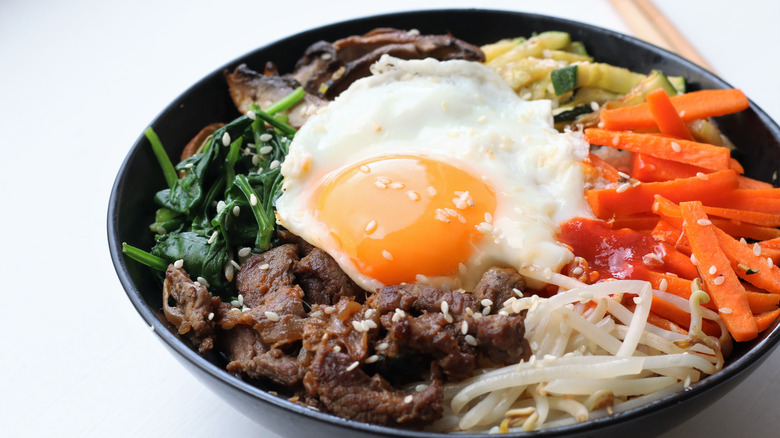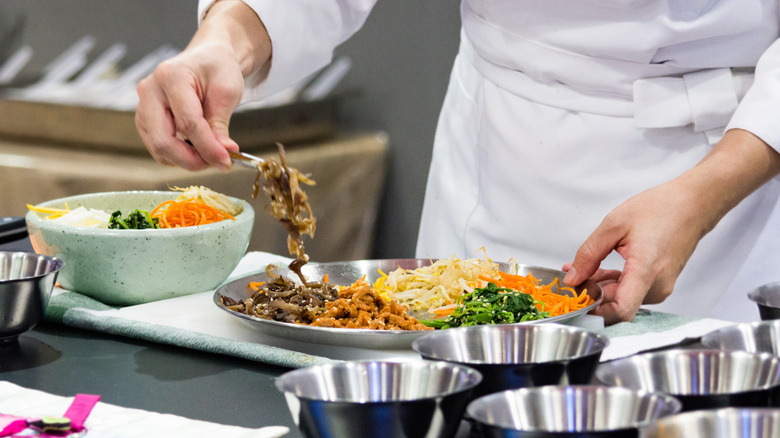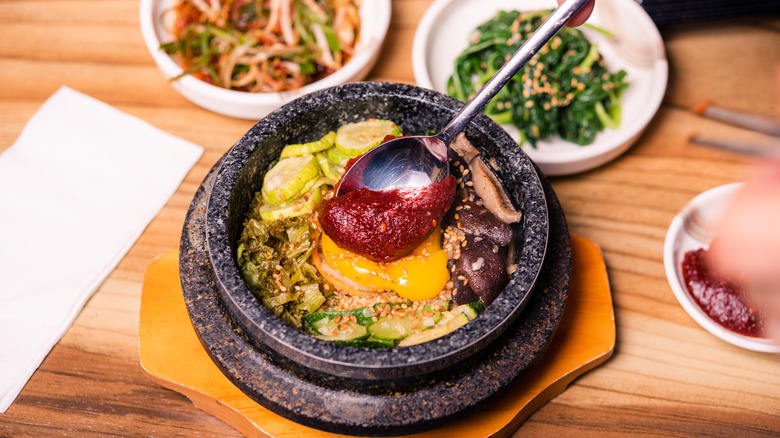What Makes Dolsot Bibimbap Unique
An array of sauteed vegetables, marinated meat, and a sunny-side-up egg all artistically spread out on a bed of fluffy white rice. It's art in a bowl. Or as the Koreans call it, bibimbap. The name is derived from "bibim," which means mixing, and "bap" for rice, per Korean Bapsang. The cook assembles the ingredients artfully in the bowl, which is then brought to the diner to mix. It's also the diner's responsibility to add as much gochujang (red pepper sauce) as they want.
A classic recipe for bibimbap shared by Recipe Tin Eats calls for shiitake mushrooms, zucchini, carrot, spinach, and bean sprouts. The meat (usually beef) also needs to be marinated with garlic, beef, sesame oil, apple, honey, soy sauce, and rice vinegar in the style of bulgogi beef. Maangchi recommends using filet mignon or flank steak for the meat. If you have access to the ingredients, Maangchi's version also includes fresh fernbrake (fiddleheads), or dried fernbrake that has been soaked, as well as dried bellflower roots. The dried bellflower roots need to be soaked in cold water for between 18 and 24 hours.
If you want to keep the recipe simple, the author says you can just use soybean sprouts, spinach, carrot (or red bell pepper), gochujang, toasted sesame oil, and egg. Other common vegetables for bibimbap, per Korean Bapsang, are cucumber, onion, radish, lettuce, red cabbage, kimchi, and nori (roasted seaweed sheet).
The history of bibimbap
Bibimbap is a modern-day favorite in Korea where it was created a bit over a century ago, according to Fine Dining Lovers. But the idea of taking rice and toppings and mixing them all in a bowl with sauce is much older. Fine Dining Lovers reports that during the Joseon Period in Korea (14th-16th centuries), a dish called goldongban was enjoyed. Unlike the modern bibimbap, it was not a commonly eaten dish, instead being consumed only on the eve of the lunar new year. The dish was the result of people wanting to empty their pantries and start fresh in the new year.
The first records of what could be considered bibimbap date to the late 1800s, per Bibigo. But the first time bibimbap is referred to by name is in a cookbook called "Siuijeonseo" from the same time (via Fine Dining Lovers). It's been suggested that bibimbap was created as a way to feed farmers and farmhands during harvest because it could easily be made in large amounts. Bibimbap gained more international recognition in the 1990s when it was served on Korean Air flights, says Bibigo.
What ingredients are in dolsot bibimbap?
Of the variations on the classic bibimbap dish, dolsot bibimbap is the most common. Literally meaning "stone pot" bibimbap, the dish is served in a hot stone bowl, per Korean Bapsang. Made with the same ingredients as the classic bibimbap, which is commonly served at room temperature, the dolsot version is cooked in a stone pot. The pot is coated with sesame oil, which allows the bottom layer of rice to brown and form a crunchy layer, per Kimchi Mari. For the toppings in a dolsot bibimbap, Maangchi says to top it with a raw egg yolk when serving. The reason a raw rather than fried egg is used for dolsot bibimbap is that the heat from the rice and bowl cooks the egg as it's stirred in, per Kimchi Mari.
Once assembled, the bowl of ingredients can be placed on a stove burner for about 10 minutes (covered for the first 3-4 minutes). It is then cooked until the rice starts to sizzle, Kimchi Mari says. Just like the classic bibimbap recipe, the diners determine how much gochujang they want to put in their dish at the table.
Don't forget to sprinkle sesame seeds on the dolsot bibimbap and to mix well for a complex, flavorful bowl of goodness. Then grab a spoon and dig in!


